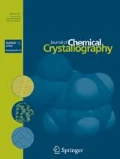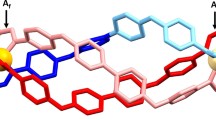Abstract
In the solid state diallylamine forms supramolecular helices with four molecules per pitch that are held together by hydrogen bonding. The helical structure is the result of competing length scales at which hydrogen bonding and second-neighbour Van-der-Waals interactions occur. The structure features two crystallographically independent helices and four unique molecules in the asymmetric unit (Z′ = 4). The high Z′ value is partly a consequence of the centrosymmetric pseudo-hexagonal packing of helical columns, which is incompatible with helical spacegroup symmetries.
Graphic Abstract

Similar content being viewed by others
Introduction
Helical arrangements are frequently observed in crystal structures of small molecules that form hydrogen bonded chains such as simple alcohols [1,2,3] or amines [4, 5]. Recently, we have found that many of these helices are only stable when being reinforced by the crystal packing but would otherwise collapse into ring structures. In contrast, helices of dialkylamines equipped with small alkyl groups have shown to be inherently stable [6]. Out of this series diethylamine is the smallest and simplest molecule that has a supramolecular helix as its most stable aggregate. The two ethyl groups flank the central H-bonding site which is sufficient to prevent ring formation. The helical twist is a consequence of competing length scales of hydrogen bonding and second neighbour interactions between alkyl groups. Larger substituents, on the other hand, inhibit chain formation while methyl groups are too small to induce a helical twist. We were interested how diallylamine would fit into this series since it is of similar size and shape as dialkylamines that support supramolecular helices.
Experimental
Diallylamine was purchased from Sigma-Aldrich and used without further purification. It is a liquid at room temperature; its melting point was measured at 185 K (− 88 °C). Single crystals were obtained using the zone-melting technique described by Boese and Nussbaumer [7]: The liquid sample was filled into a capillary of 0.5 mm diameter, which was mounted onto the diffractometer. The sample was flash-frozen at 100 K using a Cryostream (Oxford Cryosystems) and then subjected to successive heating scans along the capillary using an infrared laser until sufficiently large single crystals had formed.
Intensity data were collected on a Bruker Apex II diffractometer with Mo Kα radiation at 100 K; ω-scans were performed in 0.5° steps. The experimental setup required that the capillary was kept always in vertical alignment, which limited the coverage of reflections to 91%.The crystal structure was solved with Direct Methods and refined against F2 using full-matrix least-squares (SHELXL) [8]. C and N atoms were refined anisotropically. The positional parameters of N-bonded H-atoms were refined freely, while C-bonded H-atoms were fixed in geometrical positions. Table 1 lists the crystallographic data. Full lists of bond lengths, bond angles, torsion angles, hydrogen bonding parameters and atomic coordinates can be found in the Supporting Information.
Results and Discussion
The crystal structure of diallylamine (space group P21/n, no. 14) consists of two crystallographically unique helical strands each containing four molecules per repeat unit of which two are symmetrically independent (Z′ = 4). The helices are packed parallel to the crystallographic b-axis and coincide with the 21-screw axes (see Fig. 1). The N⋯N distances across N–H⋯N interactions range between 3.195 (4) and 3.327 (3) Å, which is similar to those observed in other dialkylamines [6]. Three of the four independent molecules are effectively symmetrical, while one adopts an asymmetric configuration (see Fig. 2). The two distinct helices of diallylamine exhibit a local 41 symmetry, however, the helix containing the asymmetric molecule is more distorted from this symmetry.
A look at the Hirshfeld surface plot [9] shows that the molecules are tilted with respect to the helical axis allowing van der Waals contacts to both second and third neighbours (see Fig. 3). The helical twist is a consequence of the interplay of hydrogen bonding and second neighbour interactions which occur at competing length scales. Third neighbour interactions were also observed for ethylisopropylamine which also exhibits a pseudo 41 helix in the crystal. In contrast, hydrogen bonded chains of dialkylamines featuring pseudo 31 helices lack such interactions [6].
Illustration of the interactions of a diallylamine molecule within the pseudo 41 helix of the crystal structure. Its neighbours are depicted with their Hirshfeld surfaces [9]. Red patches indicate H-bonding interactions (Color figure online)
Like many other solid state structures of small, achiral molecules that form polar helical chains held together by hydrogen bonds, the crystal structure of diallylamine is centrosymmetric; its helices consist of enantiomeric pairs that are aligned in anti-parallel fashion. Also, as it is often the case for helical arrangements of small achiral molecules, the crystal structure contains several molecules per asymmetric unit (Z′ > 1) [10]. Constellations with Z′ > 1 are often associated with local pseudo-symmetry of a secondary structure that is not part of the crystal symmetry [11]. In the absence of a chiral bias a centrosymmetric pseudo-hexagonal arrangement is often favoured for columnar helices, in which case Z′ must be greater than 1. A hexagonal packing that features only one molecule per asymmetric unit (Z′ = 1) is only possible for 31 and 61 helices in a chiral polar packing (see Fig. 4a); it is the only arrangement that is in agreement with a trigonal/hexagonal crystal system. The other packings (b), (c), (d) and (e) are pseudo-hexagonal; their crystal system is reduced to either triclinic, monoclinic or orthorhombic and therefore not compatible with a helical spacegroup symmetry. In such cases, Z′ can be no less than n for helices with rotation steps 360°/n (or n/2 if the helix coincides with a crystallographic 21 screw axis). The pseudo 31 helices of Et2NH and Pr2NH (Z′ = 3) form pseudo-hexagonal arrays that correspond to (e), while EtiPrNH (Z′ = 2) and diallylamine (Z′ = 4) show a packing equivalent to (d); their local 41 symmetry is reduced to a crystallographic 21 screw axis.
Hexagonal and pseudo-hexagonal packings of supramolecular columnar helices; arrows indicate the handedness and ± the polarity of helices; the smallest possible unit cells for each arrangement are displayed by the red boxes. a Chiral polar, b chiral non-polar, c achiral polar, d centrosymmetric and e centrosymmetric containing all four combinations of chirality and polarity (Color figure online)
Conclusion
Diallylamine exhibits supramolecular helices in the crystal that consist of four molecules per repeat unit. The helical structure arises because hydrogen bonding and second and third-neighbour interactions occur at competing length scales. The behaviour of diallylamine is analogous to that of dilalkylamines of similar size which form either pseudo 31 or pseudo 41 helices in the solid state. The helical columns are packed in centrosymmetric pseudo-hexagonal arrays. Since such arrangements are incompatible with helical spacegroup symmetries, the structure contains several molecule per asymmetric unit (Z′ > 1), a phenomenon that is frequently observed in helical crystal structures assembled from small molecules.
References
Ridout J, Probert MR (2014) CrystEngComm 16:7397–7400
McGregor PA, Allan DR, Parsons S, Clark SJ (2006) Acta Crystallogr Sect B 62:599–605
Ibberson RM, Parsons S, Allan DR, Bell AMT (2008) Acta Crystallogr Sect B 64:573–582
Dobrzycki L, Taraszewska P, Boese R, Cyrański MK, Cirkel SA (2015) Angew Chem Int Ed 54:10138–10144
Podsiadło M, Olejniczak A, Katrusiak A (2017) Cryst Growth Des 17:2218–2222
Hanke F, Pugh CJ, Kay EF, Taylor JB, Todd SM, Robertson CM, Slater BJ, Steiner A (2018) Chem Commun 54:6012–6015
Boese R, Nussbaumer M (1994) In situ crystallisation techniques. Oxford University Press, Oxford
Sheldrick GM (2015) Acta Crystallogr Sect C 71:3–8
Spackman MA, McKinnon JJ (2002) CrystEngComm 4:378–392
Brock CP, Duncan LL (1994) Chem Mater 6:1307–1312
Steed KM, Steed JW (2015) Chem Rev 115:2895–2933
Author information
Authors and Affiliations
Corresponding author
Additional information
Publisher's Note
Springer Nature remains neutral with regard to jurisdictional claims in published maps and institutional affiliations.
Electronic supplementary material
Below is the link to the electronic supplementary material.
Rights and permissions
Open Access This article is distributed under the terms of the Creative Commons Attribution 4.0 International License (http://creativecommons.org/licenses/by/4.0/), which permits unrestricted use, distribution, and reproduction in any medium, provided you give appropriate credit to the original author(s) and the source, provide a link to the Creative Commons license, and indicate if changes were made.
About this article
Cite this article
Pugh, C.J., Robertson, C.M. & Steiner, A. The Helical Structure of Diallylamine in the Solid State. J Chem Crystallogr 50, 422–427 (2020). https://doi.org/10.1007/s10870-019-00816-2
Received:
Accepted:
Published:
Issue Date:
DOI: https://doi.org/10.1007/s10870-019-00816-2








